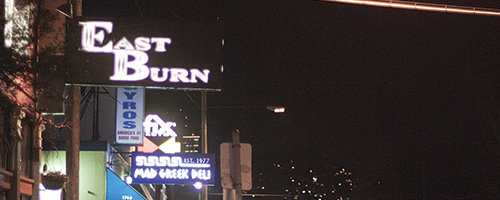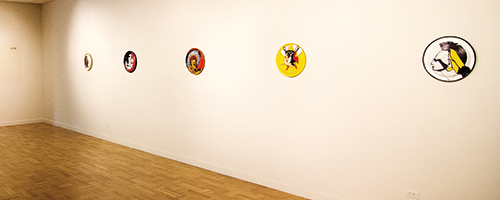A walk in the woods
For those of us who have experience with good luck, we know it’s about being in the right place at the right time, with the right people, and in the right state of mind. One could argue that experiencing good art is a lot like good luck; it takes the right combination of people, space, timing and a little insight. Jennifer Armburst, the proprietor of Motel Gallery (19 N.W. Fifth Ave.), has a firm grip on good art. She consistently hosts Portland’s finest cutting-edge art shows by balancing all the right components. Motel Gallery is a flophouse for the brilliant.
What is the point? Why did you create Motel?
Motel was created to offer a venue for the incredible concentration of young artists here who were unable to crack into the established galleries. There were a lot of warehouse shows and underground art events going on when I moved here four years ago and it seemed relevant and exciting to build someplace where that same organic inspiration could exist on an ongoing basis. Plus, it’s the best excuse ever to be my own boss, practice total creative freedom and get to know people who are making things I admire.
Are you an artist yourself? What do you like to make?
I am a graphic designer. I do all of Motel’s design and identity. I also designed, built and maintain the web site. When life isn’t so busy, I like to get crafty, you know, sewing, knitting and making lovelies for my home.
Has it been difficult finding talent for the gallery?
No. That’s the easy part. (We are not accepting submissions!) But sometimes it does take a lot of planning, months in advance, and it can be rough to stay on top of the game to make sure everything is lined up six to 12 months ahead of time.
Who are some of your favorite artists?
Well, the easy and honest answer is that my favorite artists are generally those I show at Motel. A short list: Carson Ellis, Jen Corace, Jessie Vala, Souther Salazar, Andrew Brandou, Jacob Magraw, Rachell Sumpter, Bwana Spoons, Ryan Jacob Smith. What I love about these artists is that while they are all working from an illustrative tradition, they each have a very distinctive style, which is the result of skill, talent, passion and an ability to create un-self-consciously. The three artists that have had a seminal influence on my own life and creative development are Yoko Ono and Charles and Ray Eames.
Since you have your finger on the underground art world pulse, can you say you’ve noticed any new trends?
The art world, much like greater society, is constantly morphing, adapting and reinventing itself. And, as in the larger social schema, there’s always resistance from the establishment, which inevitably spawns new and rebellious forms. Narrative illustration is slowly being accepted as a legitimate art form. This has been happening over the past couple of generations but I think that young artists are finding a lot of resonance with this more literal, linear art form and it will continue to proliferate. Of course, as that happens, though, it becomes more difficult to spot the ones who will endure. Other trends are the obvious marriage of technology and art as computers become more powerful and ubiquitous, and the commingling of design and fine art. I’m not so sure that I would define these as trends, though, because I think they have more influence and power than that; I think these may be actual “movements” but only time will tell.
Well, to each his own. I think the only trend that I’m kind of getting burned out on is half-baked ideas and execution. This isn’t a trend, though; it’s a pervasive problem of fear, ego and laziness. Although I do believe that all people are essentially creative, not everyone is an artist. If you are going to become an artist, commit yourself wholly and don’t give up. Work to convey something that moves you. Identify what it is you love about those you are influenced by and take that and elaborate on it with your own artistic voice. I don’t need to see another portfolio that is homage to your love of (enter any given artist here).
How is it that you consistently organize the most radical shows in Portland? How do you find such amazing artists?
Um, thanks for the compliment. There’s a lot of good art going on all over the city. I just happen to be one of the few venues completely committed to emerging artists. I curate to taste, which usually works pretty well for me. I don’t have a formula of we need X number of photography shows and Y number of painting shows and Z number sculpture. I go with what grabs me. Most all decisions I make with Motel are intuitive; I try to go with my gut and not think too much. As for finding artists, at this point, I have shown over 100 artists, which has given me a good sense of who fits well in the space and who I trust to meet their commitments with me. Those are the artists who I bring back on a regular basis. When I introduce new artists to the gallery, it is usually someone who comes on a good recommendation or whom I have met through these trusted artists. I like to ask artists whom I respect personally and professionally who they’re into because they tend to have their finger even closer to the pulse than I do. Of course, I also find artists through other galleries, indie art magazines and the web. I hate to disappoint your BFA students but I almost never curate from a submitted portfolio. This has only happened once or twice.
I love the current show. It’s three fellows, Calef Brown and Jacob Magraw-Mikelson from L.A. and Ross Christy from Portland. Jacob and Calef both create these incredibly intuitive, detailed drawings. Working with fine point pen, they generate these stream-of-consciousness pieces dense with fragments, stories, characters and moments. I bought a piece of Jacob’s with airplanes when he had work in our February group show. Its got a million little things going on with pieces of paper and pen and paint and yet it’s very small, just one by two inches, and absolutely enchanting. That’s how all of Jacob’s work is. Ross’ work offers a nice contrast to the other two because the pieces are quite large with very steady, soft line work and watercolor on paper. They have a naturalist slant, offering homage to the wilderness. This month was a short run with only three weeks. I would have liked to keep the exhibition up longer, but alas, the show must go on.
Out of all the major art cities in the world, why Portland?
Stick around another five to 10 years and you’ll know.
What is with the deer in the Motel logo?
It’s a visual referent. I’m sure there are probably volumes of marketing theory on why a logo is important. It’s a symbolic visual component so that I don’t have to use text for people to make an association with Motel. It was a subconscious design decision; I loved the look and feel of it. The logo was one of the first things I did once I knew I was going to open Motel. The name and imagery came together very quickly.
For more info, visit www.motelgallery.com




